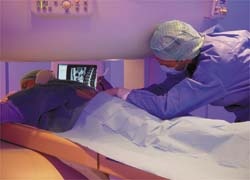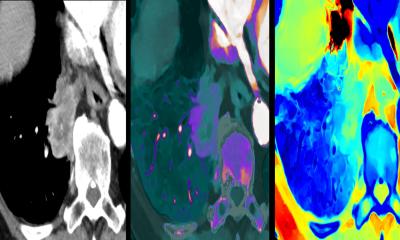Open High-field MRI
Microtherapeutic interventions under radiological image control
As part of a research and development project, doctors at the University Hospital Magdeburg, Germany, are treating oncology patients with local minimally invasive surgery (MIS) which, for the first time, can be carried out under radiological image control using high-field magnetic resonance imaging (MRI). The system offers excellent image quality under extremely favourable, radiation-free conditions.

Due to the closed, tube-shaped construction of magnetic resonance tomographs, minimally invasive interventions have so far been controlled with the help of ultrasound or CT. However, both procedures have their disadvantages — either the image quality is not ideal or a patient is exposed to additional radiation.
Open high-field MRI can significantly improve micro-surgical procedures. ‘This equipment is a milestone for microtherapy: Due to its open construction it offers us doctors the important, free access to the patient which we need for these procedures,’ explained Prof. Jens Ricke, Director of the Clinic for Radiology and Nuclear Medicine at the University Hospital Magdeburg. ‘Moreover, the new system shows soft tissues with excellent image quality and works without ionising radiation.’
The open version of MRI enables the implementation of microsurgical procedures near tumours, under permanent image control. First studies indicate that minimally invasive procedures, such as image-guided brachytherapy or thermal radiofrequency ablation combined with conventional surgical or chemotherapeutical treatment, can achieve better therapy success with lower follow-up costs.
As part of the project, which the university hospital started with Philips Healthcare, the development of new procedures, such as those against chronic pain, is also to be promoted. There is to be particular emphasis on interdisciplinary co-operation. ‘Microtherapeutic interventions are always part of a whole, interdisciplinary concept. The University Hospital Magdeburg develops an individual treatment plan for every patient and puts it into practice, with close cooperation of all specialised areas of medicine involved in the delivery of oncological therapy,’ Philips pointed out.
01.03.2008











